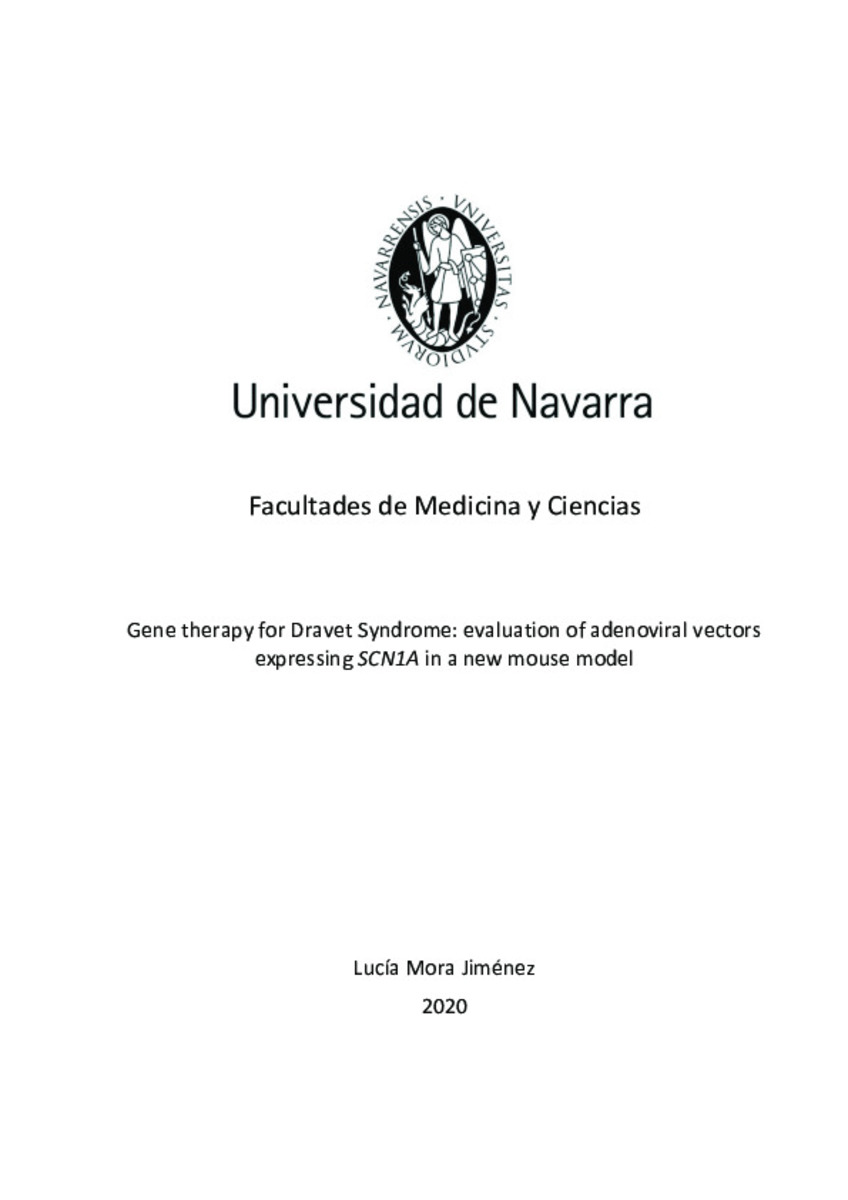Full metadata record
| DC Field | Value | Language |
|---|---|---|
| dc.contributor.advisor | Hernandez-Alcoceba, R. (Rubén) | - |
| dc.contributor.advisor | Ricobaraza, A. (Ana) | - |
| dc.creator | Mora-Jiménez, L. (Lucía) | - |
| dc.date.accessioned | 2021-07-06T09:30:54Z | - |
| dc.date.available | 2021-07-06T09:30:54Z | - |
| dc.date.issued | 2021-07-06 | - |
| dc.date.submitted | 2020-12-18 | - |
| dc.identifier.citation | MORA JIMÉNEZ, Lucía. “Gene therapy for Dravet Syndrome: Evaluation of adenoviral vectors expressing SCN1A in a new mouse model". Hernández, R. y Ricobaraza, A. L. (dirs.). Tesis doctoral. Universidad de Navarra, Pamplona, 2020. | es_ES |
| dc.identifier.uri | https://hdl.handle.net/10171/61043 | - |
| dc.description.abstract | Dravet Syndrome (DS) is a severe encephalopathy with infantile onset, characterized by seizures refractory to conventional antiepileptic drugs, increased risk of sudden unexpected death in epilepsy (SUDEP), as well as cognitive, behavioral and motor comorbidities. The vast majority of DS cases are caused by heterozygous de novo mutations in the SCN1A gene, which encodes the alpha subunit of a voltage-dependent sodium channel called Nav1.1. The defect of Nav1.1 channels particularly affects the function of GABAergic inhibitory neurons causing a general hyperexcitability in the brain, accounting for epileptic and neurological comorbidities. Preclinical development of new therapeutic approaches requires animal models which represent the disease at genotypic and phenotypic levels. In the present thesis project is described a novel knock-in mouse model carrying a clinically relevant SCN1A mutation (A1783V) in all body cells in the C57BL/6 background that present a full spectrum of DS manifestations. Additionally, it has been provided a proof of concept that a High-Capacity Adenoviral (HC-AdV) vector expressing an optimized version of the SCN1A coding sequence under the control of the ubiquitous promoter CAG (HCA-CAG-SCN1A) is feasible and able to express functional Nav1.1 channel in vitro and in vivo. Therapeutic evaluation of this prototypic vector was performed according to the best biodistribution observed after stereotaxic injection in prefrontal cortex (pCtx), basal ganglia (BG), and cerebellum (Cb). When adolescent DS mice already suffering most disease manifestations received the HCA-CAG-SCN1A vector they were protected from SUDEP, showing improvement in hyperthermal-induced seizures, electrophysiological activity, interaction with the environment and prevention from motor impairment. Memory dysfunction was partially ameliorated, although hyperactive and anxious behavior failed to be corrected. These results indicate that gene transfer of full SCN1A sequence using HC-AdV vector is safe and potentially efficacious for the treatment of DS, offering new opportunities for improvement of therapeutic approaches. | es_ES |
| dc.language.iso | eng | es_ES |
| dc.publisher | Universidad de Navarra | es_ES |
| dc.rights | info:eu-repo/semantics/openAccess | * |
| dc.subject | Materias Investigacion::Ciencias de la Salud::Genética | es_ES |
| dc.subject | Ingeniería genética | es_ES |
| dc.title | Gene therapy for Dravet Syndrome: Evaluation of adenoviral vectors expressing SCN1A in a new mouse model | es_ES |
| dc.type | info:eu-repo/semantics/doctoralThesis | es_ES |
Files in This Item:
Statistics and impact
Items in Dadun are protected by copyright, with all rights reserved, unless otherwise indicated.






